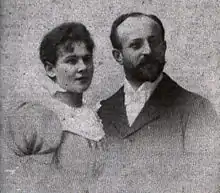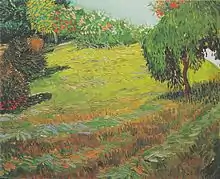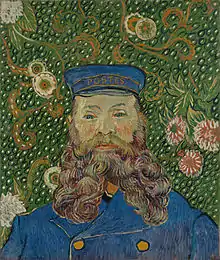Bernhard Mayer
Bernhard Mayer (July 22, 1866 – July 18, 1946[1]) was a German fur trader, anarchist, patron and art collector.[2] He laid the foundation for the Merzbacher Collection which is currently housed at Kunsthaus Zürich.
Bernhard Mayer | |
|---|---|
 Auguste and Bernhard Mayer, 1897 | |
| Born | Bernhard Mayer July 22, 1866 |
| Died | July 18, 1946 (aged 79) |
| Nationality | German |
| Other names | Mink Bernardo |
| Occupation(s) | Fur trader, art collector |
| Known for | Founding of Merzbacher Collection |
| Children | 2 |



Early life and education
Bernhard Mayer came from a Jewish family from the Hunsrück region. His father ran a grocery store, his mother was a housewife. At the age of eleven, he left his parents to attend school in Bad Kreuznach. He broke off his education and worked first in Simmern, then Saarbrücken, Saargemünd and finally in 1885 in Aachen.[3] He completed an apprenticeship as furrier in Brussels, Belgium.
Career
In 1895 he started his business as fur trader and after initial difficulties his fur business flourished and he opened branches in Paris, Berlin, Zurich and Amsterdam, run by members of the family.[3] The poet Else Lasker-Schüler jokingly called him Mink Bernardo.
Art collector
In Brussels in 1903 he had bought two pictures from an outsider, James Ensor, as support; Guste and he thus laid the foundation for an unsystematically built up collection of pictures.[3] The Munich art historian Franz Stadler encouraged him to buy pictures by French Impressionists, but only first-class works. In 1926, Mr. and Mrs. Mayer had the Teatro San Materno built for the dancer Charlotte Bara in Ascona. Mayer was also otherwise active as a patron and collector of art, acquiring paintings by Cézanne, van Gogh,[4] Renoir, Matisse and Picasso, among others, primarily in the 1920s. In a hotel built especially for this purpose in Ascona, he hosted numerous writers and artists, especially emigrants, such as Holitscher, Ehrenstein, the Fritsch couple, Else Lasker-Schüler and many others. Famous first works, such as those of Ignazio Silone, were published only thanks to his financial guarantee. Where it was possible, he did it anonymously.[5][6]
Nazi persecution and emigration
In 1941, he fled from the National Socialists to the USA; he had already taken some of his pictures to safety there in 1936, while others were lost. In New York City in 1944, with Guste's help, he wrote his memoirs, which he dedicated to his four grandchildren. After the end of the war he returned with the paintings to his house in Ascona. Guste Mayer died there in 1958.
Part of his art collection found its place as inspiration, incentive and catalyst.[3] in the Merzbacher Collection of his granddaughter Gabrielle Merzbacher-Mayer and her husband Werner Merzbacher.[7][8]
Personal life
Mayer supported socialism and anarchism.[9] His connections with anarchists brought him to Ascona in 1909, where he built a home.[10] At the beginning of World War I, Mayer, as a German, had to leave Belgium; he went to Berlin and in 1916 to Zurich, then to Ascona.
Selected works
- Bernhard Mayer: Interessante Zeitgenossen. Lebenserinnerungen eines jüdischen Kaufmanns und Weltbürgers. Hrsg. von Erhard Roy Wiehn. Hartung-Gorre Verlag, Konstanz 1998 (Autobiographie und Beiträge, deutsch und engl.), ISBN 3-89191-888-7.
References
- Wasensteiner, Lucy (9 October 2018). The Twentieth Century German Art Exhibition: Answering Degenerate Art in ... - Lucy Wasensteiner - Google Books. Routledge. ISBN 9781351004121. Archived from the original on 2022-02-26. Retrieved 2022-02-26.
- Tribune, International Herald (1998-06-12). "Arts Guide". The New York Times. ISSN 0362-4331. Archived from the original on 2022-02-19. Retrieved 2022-02-19.
Zurich Kunsthaus, tel: (1) 251-6765, closed Mondays. To Aug. 23: "The Bernhard Mayer Collection." From the collection of the German-born art dealer (1866-1946), a selection of works by Renoir, Cezanne, van Gogh, Picasso and Jawlensky.
- Stephanie Rachum: Eine Geschichte aus zwei Sammlungen: Bernhard und Auguste Mayer / Werner und Gabriele Merzbacher. In: Bezzola; Schädler: Fest der Farbe, 2006, S. 14–28.
- "Vincent van Gogh - Portrait of Joseph Roulin". www.pubhist.com. Archived from the original on 2022-02-15. Retrieved 2022-02-15.
Provenance Theo van Gogh, Paris, 1889 Jo van Gogh-Bonger, Amsterdam, 1891 Leicester Galleries, London, 1923 Courtauld Fund Trustees, London, 1923 Tate Gallery (formerly National Gallery, Millbank), London, 1923 Leicester Galleries, London, 1924 Thannhauser Gallery, Lucerne, 1924 Bernhard Mayer, Zurich, 1926 Ernst Mayer, Zurich and Ascona, 1946 Gabrielle Mayer, Switzerland Private collection, 1987 Thomas Ammann Gallery, Zurich Museum of Modern Art, New York, 1989
- Harald, Szeemann (1998). Die Sammlung Bernhard Mayer. Kunsthaus Zürich. ISBN 3-906574-03-2. OCLC 901136178. Archived from the original on 2022-02-26. Retrieved 2022-02-15.
- V. G.: In memoriam Bernhard Mayer. In: Interessante Zeitgenossen. Lebenserinnerungen eines jüdischen Kaufmanns und Weltbürgers. S. 346.
- Sontag, Deborah (1999-01-26). "ARTS ABROAD; A Private Collector Delights the Israeli Public". The New York Times. ISSN 0362-4331. Archived from the original on 2015-05-27. Retrieved 2022-02-15.
- "Sammlung Merzbacher – KUNSTHAUS". www.kunsthaus.ch. Archived from the original on 2022-02-15. Retrieved 2022-02-15.
The starting point of the collection is the exclusive group of exceptional works that Gabriele Merzbacher-Mayer inherited from her grandparents Bernhard and Auguste Mayer and that, since the 1960s, has been progressively enriched through further acquisitions of great art.
- Rachum 2006, p. 14.
- Rachum 2006, p. 8.
Bibliography
- Rachum, Stephanie (2006). "A Tale of Two Collections: Bernhard and Auguste Mayer, Werner and Gabrielle Merzbacher". In Kunsthaus Zürich (ed.). Feast of Color: The Merzbacher-Mayer Collection. Cologne: DuMont. pp. 14–27. ISBN 978-3-8321-7687-7. OCLC 65166666.
Further reading
- Christian Klemm (Hrsg.): Die Sammlung Bernhard Mayer : Ausstellung im Kunsthaus Zürich, 19. Juni bis 23. August 1998. Kunsthaus, Zürich 1998.
- darin: Harald Szeemann: Die Sammlung Bernhard Mayer. S. 9–16.
- Hans-Werner Johann: Bernhard Mayer: Jugenderinnerungen eines Laufersweiler Juden. Wiedergegeben und ergänzt von Hans-Werner Johann in Glaube und Heimat, Nr. 9–12, 1991